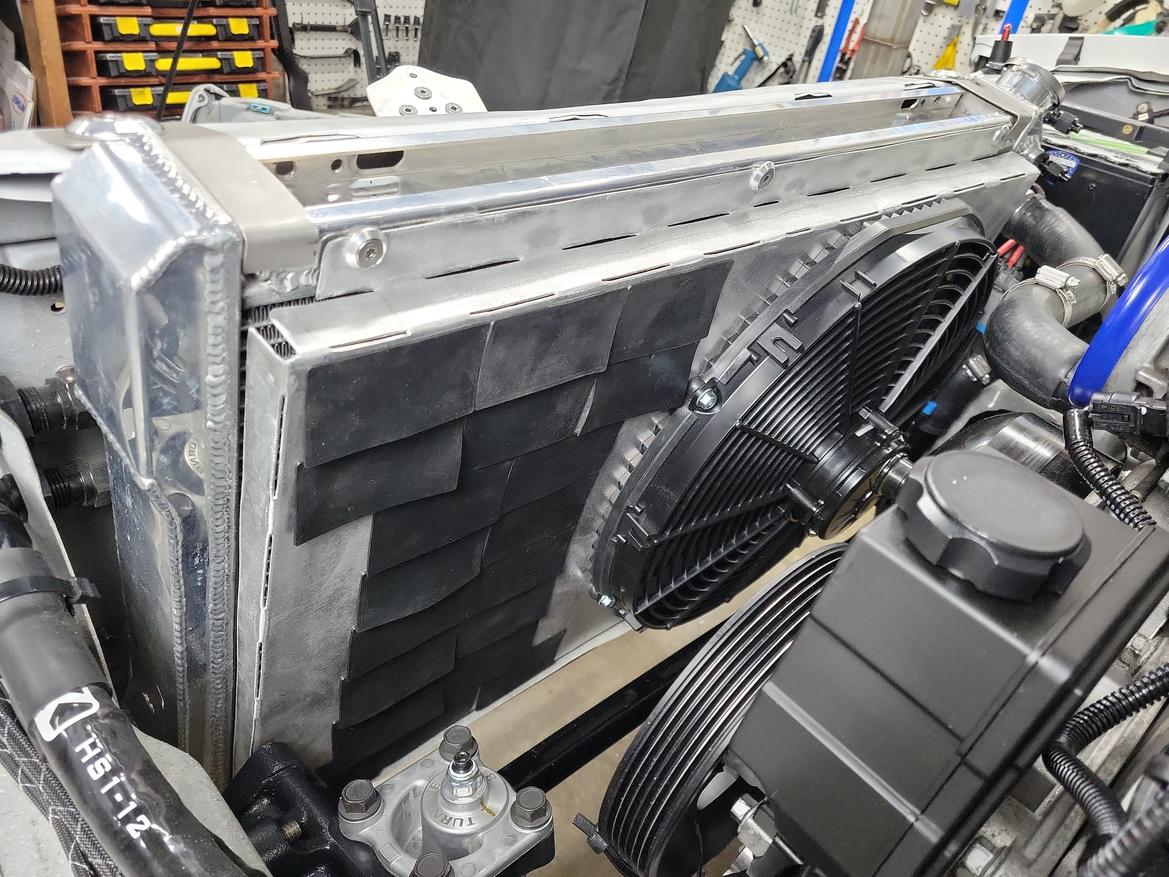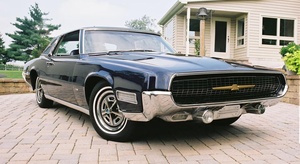92RS said:
If my car doesn't break at this weekend's autocross, I'll schedule a Track day and test the fan ON and OFF.
Might try to make a Oil cooler shroud like another post said as well. I think my oil cooler is about 3/4in away from the radiator.
My new shroud/Fan combo works crazy well compared to the LS1 fans set up I had before. (5lbs less too) The flaps 1/2 open at 35mph so I'll have to see at higher speeds if they fully open.


Unless there are a bunch of panels missing in front of that radiator, air is going under and around that radiator and not through it.

92RS
New Reader
4/15/25 8:04 p.m.
In reply to wvumtnbkr :
Turd gen Camaros have a bunch of duct work in front. Pic was when the car was dissembled. I taped off any cracks and gaps last season and it didn't change any cooling. Adding 7 of those SPAL flaps made a huge difference though. Like -20F on engine temp. I figured if 7 worked well might as well add 19!

I fought overheating issues on a 4th gen and one thing that actually helped a lot was to extend the airdam full width. In this car's case it had a supercharger with twin horizontal mount intercoolers in front of the wheel wells that each had their own airdam, I merely added side panels from the stock airdam to the intercooler airdams.
There is positive pressure coming forward from the front tires... and a lot of that air moving forward is radiator exit air. So preventing that airflow from recirculating like that was worth a lot.
In reply to 92RS :
What about the sides? Do you have a pic with hood open?

92RS
New Reader
4/15/25 8:23 p.m.
In reply to wvumtnbkr :
The air dams on F-bodies don't have end plates. I assume it's because they are designed to bend if you bottom out. Very hard to scrape an air dam if you run track springs.
But I can maybe test end plates though. Seems like it would direct more air through.
Assuming my new shroud doesn't work. Maybe my 1/2-ass'd diy shroud will work. I'd be happy with 200F engine and 250F oil temps.
I made test pieces out of cardboard and Coloplast. It worked well enough and was so invisible after a quick spray with black paint that he didn't bother having us make them out of rubber/plastic.

jgrewe
Dork
4/15/25 11:54 p.m.
If the fan test doesn't give you the results you are looking for I would work on the shrouding in front of the radiator. After a quick look at the pics I think I see what is going on. The air that is brought in through the grill is dumped in front of the core a little higher up. There is nothing keeping the air from sneaking around the radiator by going under it. The little chin spoiler helps a bit.
I would get rid of the license plate hunk in the center of the grill opening and lose all the stock shrouding. Then make a simple shroud that makes sure all the air that comes through the grill has to go through the radiator.
The second post on page 3 of my E46 build shows what I mean.
https://grassrootsmotorsports.com/forum/build-projects-and-project-cars/grm-is-totally-to-blame-for-this-spec-e46-content/259206/page3/
I still have more that I can do to improve the ducting on that car if I need. I will probably add a few things to seal the gap around the oil cooler/radiator gap before I run again. I'll also add some plates to keep the air from spilling off the oil cooler core. Ambient temps will be higher next time it's on track.
92RS said:
In reply to wvumtnbkr :
The air dams on F-bodies don't have end plates. I assume it's because they are designed to bend if you bottom out. Very hard to scrape an air dam if you run track springs.
But I can maybe test end plates though. Seems like it would direct more air through.
Assuming my new shroud doesn't work. Maybe my 1/2-ass'd diy shroud will work. I'd be happy with 200F engine and 250F oil temps.
Not the bottom. The sides of the radiator. It looks like the air can come in the front and go left and right around the radiator.

92RS
New Reader
4/17/25 8:16 p.m.
I tested the flaps around town with a GoPro.
At around 60mph the 19 flaps are wide open. So at least that works. My LS1 just sits at the 187F thermostat opening temp if the car is moving. It will not go above that even if I drive hard. So I guess the new shroud is working. I'll see what happens on my track day.

jgrewe said:
I would get rid of the license plate hunk in the center of the grill opening and lose all the stock shrouding. Then make a simple shroud that makes sure all the air that comes through the grill has to go through the radiator.
I agree. With my bottom breather, adding front ducting helped a ton. I dropped like 15f
https://grassrootsmotorsports.com/forum/build-projects-and-project-cars/c5-corvette-track-journey/261745/page2/

wvumtnbkr said:
92RS said:
In reply to wvumtnbkr :
The air dams on F-bodies don't have end plates. I assume it's because they are designed to bend if you bottom out. Very hard to scrape an air dam if you run track springs.
But I can maybe test end plates though. Seems like it would direct more air through.
Assuming my new shroud doesn't work. Maybe my 1/2-ass'd diy shroud will work. I'd be happy with 200F engine and 250F oil temps.
Not the bottom. The sides of the radiator. It looks like the air can come in the front and go left and right around the radiator.
The front of the wheelwell is a high pressure area. Air from the wheelwells, largely from radiator exit air, will get pushed forward by the tires and back into the radiator. Lots of air may be moving through the radiator but some of it is preheated air.
I can't stress enough how important this is. It seems inconsequential but some newer cars can actually overheat on the highway if the panels that separate the wheelwells from the area in front of the radiator are missing. Tires are not efficient fans but at the RPM seen at 60+mph they don't have to be.
You have a GoPro set up to watch things? Stick some tufts of yarn in that area and see which way the air is moving.

codrus (Forum Supporter) said:
Typical high performance aftermarket fans are rated at somewhere in the range of 1000-2000 cubic feet per minute.
If you assume a 1 square foot opening in the radiator grill on the front of the car, then at 30 mph you get (30/60)*5280*1 or 2640 cubic feet per minute of air going through that opening. If you make sure that all of that air goes through the radiator rather than leaking out around the edges, then you have exceeded the performance of that fan.
Having the fan turned on at 60 mph is probably not going to help much, but it's probably not going to hurt much either. What will hurt is having a third of the radiator surface blocked off with shrouding like in the picture. I assume the little black things are vents, but you're still losing a ton of the possible surface area with the aluminum around them.
Wouldn't static pressure also be something to consider? While the cfm above 60mph will be more than the fan will the fan still provide a higher pressure forcing more air through the radiator? At speeds above 60 mph?
This is a question that I don't know the answer to.

In reply to dean1484 :
One also needs to consider the pressure drop across the radiator.
In the car that needed the fan at track days, I found that underhood pressure was high enough that at 70+mph, popping the hood would have it hover a few inches above the latch. Don't try this on a rear hinged hood  What is interesting is that this was a series 1 RX-7. Mazda reshaped the front of the car for the series 2 and 3 and the examples I have had of those did not exhibit this behavior. I have a feeling that in the case of the series 1, the fan was still able to create a higher pressure difference across the radiator simply because the engine bay was stopping up airflow relative to the inlet.
What is interesting is that this was a series 1 RX-7. Mazda reshaped the front of the car for the series 2 and 3 and the examples I have had of those did not exhibit this behavior. I have a feeling that in the case of the series 1, the fan was still able to create a higher pressure difference across the radiator simply because the engine bay was stopping up airflow relative to the inlet.
That's why some FWD cars have some seriously monster fans, like my beloved LH car fans. They have a cramped engine bay directly behind the fan, so they need some serious fan action in order to force air OUT of the engine bay, not just in to the radiator. Two moderately sized fans but the motors will draw close to 40 amps each at high speed.
BTW, the fan for a '13 GT500 is a monster that flows something like 4000cfm and is cheaper than many aftermarket units.































